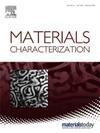输入热量对铝铜异种材料无针摩擦搅拌点焊的影响
IF 4.8
2区 材料科学
Q1 MATERIALS SCIENCE, CHARACTERIZATION & TESTING
引用次数: 0
摘要
铝/铜异种材料复合结构在先进技术和工业应用中具有重要的实用价值和潜力。本研究采用无针搅拌摩擦点焊工艺,对 2 毫米厚的 T2 铜和 1060 纯铝棒进行了搭接焊接实验。通过改变工具的停留时间,分析了铜铝界面层的演变行为和接头的机械性能。在低停留时间下,输入的热量相对较低,因此 IMC 层较薄,接头的机械性能最好,拔出力为 2238.2 N,拉伸强度为 28.49 MPa。在所有参数下,接头的断裂模式均为脆性断裂。铝/铜异种材料的连接包括两个过程:一是焊接初期以动力学为主的扩散结合;二是以热力学为主的固液瞬时结合。当焊接温度超过铝的熔点时,铝/铜界面会不断经历转化-结合-再转化过程,直至焊接过程结束。本文章由计算机程序翻译,如有差异,请以英文原文为准。
Influence of heat input on pinless friction stir spot welding of aluminum‑copper dissimilar materials
The composite structures of aluminum/copper dissimilar materials hold significant practical value and potential in advanced technology and industrial applications. This study conducted lap welding experiments on 2 mm thick T2 copper and 1060 pure aluminum rods using the pinless friction stir spot welding process. By varying the dwelling time of the tool, the evolution behavior of the Cu![]() Al interface layer and the mechanical properties of the joints were analyzed. At low dwelling times, the heat input was relatively low, resulting in a thinner IMC layer and the best mechanical properties of the joints, with a pull-out force of 2238.2 N and a tensile strength of 28.49 MPa. The fracture modes of the joints under all parameters were brittle fractures. The connection of aluminum/copper dissimilar materials involves two processes: firstly, the diffusion bonding dominated by kinetics at the initial welding stage; and secondly, the solid-liquid instantaneous bonding dominated by thermodynamics. When the welding temperature exceeds the melting point of aluminum, the aluminum/copper interface continuously undergoes transformation-bonding-retransformation processes until the welding process is completed.
Al interface layer and the mechanical properties of the joints were analyzed. At low dwelling times, the heat input was relatively low, resulting in a thinner IMC layer and the best mechanical properties of the joints, with a pull-out force of 2238.2 N and a tensile strength of 28.49 MPa. The fracture modes of the joints under all parameters were brittle fractures. The connection of aluminum/copper dissimilar materials involves two processes: firstly, the diffusion bonding dominated by kinetics at the initial welding stage; and secondly, the solid-liquid instantaneous bonding dominated by thermodynamics. When the welding temperature exceeds the melting point of aluminum, the aluminum/copper interface continuously undergoes transformation-bonding-retransformation processes until the welding process is completed.
求助全文
通过发布文献求助,成功后即可免费获取论文全文。
去求助
来源期刊

Materials Characterization
工程技术-材料科学:表征与测试
CiteScore
7.60
自引率
8.50%
发文量
746
审稿时长
36 days
期刊介绍:
Materials Characterization features original articles and state-of-the-art reviews on theoretical and practical aspects of the structure and behaviour of materials.
The Journal focuses on all characterization techniques, including all forms of microscopy (light, electron, acoustic, etc.,) and analysis (especially microanalysis and surface analytical techniques). Developments in both this wide range of techniques and their application to the quantification of the microstructure of materials are essential facets of the Journal.
The Journal provides the Materials Scientist/Engineer with up-to-date information on many types of materials with an underlying theme of explaining the behavior of materials using novel approaches. Materials covered by the journal include:
Metals & Alloys
Ceramics
Nanomaterials
Biomedical materials
Optical materials
Composites
Natural Materials.
 求助内容:
求助内容: 应助结果提醒方式:
应助结果提醒方式:


